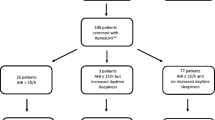Summary
Question of the Study
Only five cases of superior vena cava (SVC) thrombosis as a cuase of obstructive sleep apnoea (OSA) have as yet been reported. In this study, we aimed to describe an additional case and to review the literature on this subject.
Patients and Methods
Based on the medical records, the case history of a 58-year-old man with OSA due to SVC thrombosis is presented. Furthermore, PubMed articles were browsed with the search items ‘sleep apnoea’ and ‘superior vena cava thrombosis’.
Results
The patient complained of the development of facial swelling and plethora during the previous 2 months. Furthermore, he reported the recent onset of snoring and excessive daytime sleepiness. Computed tomography of the thorax and mediastinal phlebography showed SVC thrombosis. Polysomnography demonstrated moderate to severe OSA. The cases of OSA secondary to SVC thrombosis already reported in the literature were mainly caused by mediastinal tumours compressing the SVC. In the present case, we found activated protein C (APC) resistance as the underlying disease. From the literature, it is known that therapies aimed at recanalization or relief of the SVC might lead to reversal of the OSA. In our patient, recanalization of the SVC was not possible and thus he had to be treated by continuous positive airway pressure therapy.
Conclusion
In summary, we report on the rare occurrence of OSA due to SVC thrombosis. In the present case we found APC resistance as the underlying disease, which has not yet been reported in the literature.
Zusammenfasung
Fragestellung
Nur fünf Fälle einer obstruktive Schlaf-Apnoe (OSA) infolge einer Thrombose der oberen Hohlvene (superior vena cava; SVC) sind bisher beschrieben worden. In dieser Fallstudie möchten wir einen weiteren Fall vorstellen und eine Literaturübersicht zu diesem Syndrom geben.
Methodik
Basierend auf den Krankenakten wird der Krankheitsverlauf eines 58-jährigen Patienten mit OSA infolge einer SVC-Thrombose dargestellt. Weiterhin wurde PubMed mit den Suchbegriffen “sleep apnoea” und “superior vena cava thrombosis” durchsucht.
Ergebnisse
Der Patient litt unter einer Schwellung und Plethora des Gesichtes seit ungefähr zwei Monaten. Weiterhin gab er an, seit kurzem zu schnarchen und sich tagsüber müde zu fühlen. Ein Thorax-CT und eine Mediastinalphlebographie zeigten eine SVC-Thrombose. Polysomnographisch wurde eine mittel- bis höhergradige OSA gefunden. Bei den in der Literatur dokumentierten Fällen war die SVC-Thrombose meistens durch einen Mediastinaltumor mit Kompression der SVC verursacht. Im vorliegenden Fall wurde eine Resistenz gegenüber aktiviertem Protein C (APC) als auslösende Erkrankung festgestellt. Bekannt ist, dass Therapieverfahren, die auf eine Rekanalisation oder Entlastung der SVC abzielen, zur Rückbildung der OSA führen können. Bei unserem Patienten war dies nicht möglich, so dass er schließlich mit einem CPAP-Gerät versorgt werden musste.
Schlussfolgerung
Zusammenfassend stellen wir den seltenen Fall einer OSA infolge SVC-Thrombose vor. Als auslösende Erkrankung wurde eine APC-Resistenz gefunden, was in der Literatur noch nicht beschrieben ist.
Similar content being viewed by others
References
Bokinsky G, Miller M, Ault K, Husband P, Mitchell J: Spontaneous platelet activation and aggregation during obstructive sleep apnea and its response to therapy with continuous positive airway pressure. Chest 108: 625–630, 1995.
Chin K, Kita H, Noguchi T, Otsuka N, Tsuboi T, Nakamura T, Shinizu K, Mishima M, Ohi M: Improvement of factor VII clotting activity following long-term NCPAP treatment in obstructive sleep apnoea syndrome. QJM 91: 627–633, 1998.
Fernandez B, Smolley LA, Swirsky SM, Kaye MD: Relief of sleep apnea after intravascular stenting for superior vena cava syndrome. Vasc Med 4: 33–36, 1999.
Fuyuno G, Kobayashi R, Iga R, Notori H, Kodera K, Morinaga S: Obstructive sleep apnea syndrome associated with superior vena cava syndrome. Nippon Shikkan Gakkai Zasshi 33: 322–326, 1995.
Hoffstein V, Herridge M, Mateika S, Redline S, Strohl KP: Hematocrit levels in sleep apnea. Chest 106: 787–791, 1994.
Ito M, Tanaka J, Kubota K, Sato H, Takahashi M, Tanaka H, Ohdaira T, Yoshizawa H, Muramatsu Y Satoh M, Suzuki E, Arakawa M, Gejyo F: Obstructive sleep apnea syndrome in a patient with superior vena cava syndrome caused by lung cancer. Nihon Kokyuki Gakkai Zasshi 38: 471–475, 2000.
Langevin B, Sukkar F, Leger P, Guez A, Robert D: Sleep apnea syndromes (SAS) of specific etiology: review and incidence from a sleep laboratory. Sleep 15: S25-S32, 1992.
Provenzale JM, Frush DP, Ortel TL: Recurrent thrombosis of the superior vena cava associated with activated protein C resistance: imaging finding. Pediatr Radiol 28: 597–598, 1998.
Rangemark C, Hedner JA, Carlson JT, Gleerup G, Winther K: Platelet function and fibrinolytic activity in hypertensive and nonnotensive sleep apnea patients. Sleep 18: 188–194, 1995.
Stradling JR, Huddart S, Arnold AG: Sleep apnoea syndrome caused by neurofibromatosis and superior vena caval obstruction. Thorax 36: 634–635, 1981.
Ustundag Y, Bayraktar Y, Emri S: Superior vena cava thrombosis and obstructiva sleep apnea in a patient with familial Mediterranean fever. Am J Med Sci. 316: 53–55, 1998.
Wessendorf TE, Thilmann AF, Wang YM, Schreiber A, Konietzko N, Teschler H: Fibrinogen levels and obstructive sleep apnea in ischemic stroke. Am J Respir Crit Care Med 162: 2039–2042, 2000.
Author information
Authors and Affiliations
Corresponding author
Rights and permissions
About this article
Cite this article
Schulz, R., Fegbeutel, C., Hackstein, N. et al. Obstructive sleep apnoea secondary to superior vena cava thrombosis in a patient with activated protein C resistance. Somnologie 6, 173–175 (2002). https://doi.org/10.1046/j.1439-054X.2002.02196.x
Issue Date:
DOI: https://doi.org/10.1046/j.1439-054X.2002.02196.x




